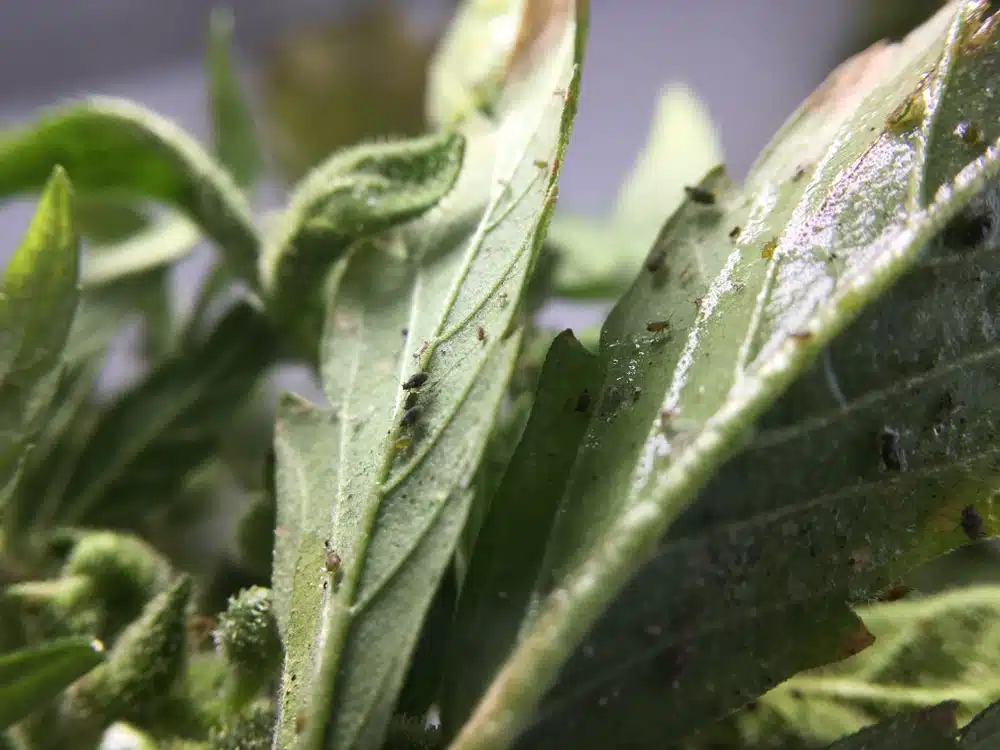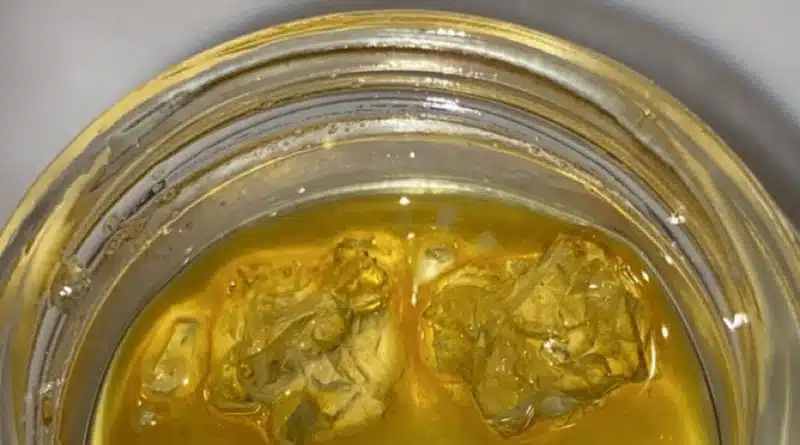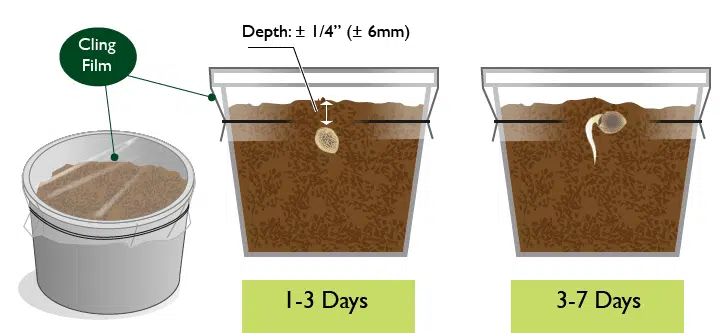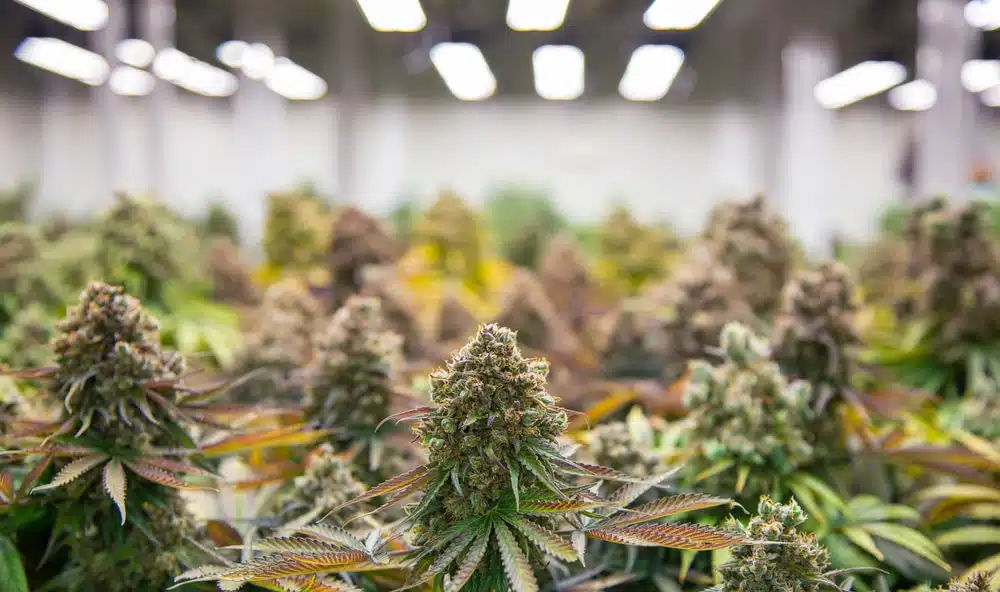How to Get Rid of Fungus Gnats in Cannabis Plants
Dealing with fungus gnats in cannabis can be challenging, as these pests can wreak havoc on your plants. They damage weed by inhibiting its growth and affecting its overall health. These insects can also infect the soil, making it difficult for crops to develop.
Once you notice fungus gnats, look for effective ways to eliminate them as quickly as possible. How can you get rid of these pests and prevent them from infesting your crops? Can you recognize the presence of these insects around your cannabis plant?
Let’s explore the various ways to identify, eradicate, and prevent gnats on weed.
What are fungus gnats?
Fungus gnats are dark-colored insects of the Diptera order known for attacking indoor plants. They measure only 3–5 mm long and live in damp areas with low light intensity. These pests have black heads and dark wings and look like tiny mosquitoes.
Although scientists have only found around 1,700 species of these parasites, many believe there are more than 20,000 varieties. Also called sciarid flies, fungus gnats eat plant roots, molasses, grass clippings, and decaying organic items.
Since these insects don’t spread diseases or bite, they’re incapable of hurting humans. They only harm your plant’s soil and root system. The problem often spreads to the leaves, stems, and other parts of the crops.

Where do fungus gnats come from?
Fungus gnats on weed plants are attracted to the dampness around crops and lay their eggs in moisture-rich areas. They tend to hide under the soil where it’s difficult to notice them. Since they develop quickly, growers often don’t see them until they start damaging their plants.
The fungus gnat life cycle
Fungus gnats undergo complete metamorphosis, involving four distinct developmental stages:
- Egg
- Larva
- Pupa
- Adult
When in a conducive environment, an adult female gnat can lay as many as 200 eggs in the soil. After about 4–6 days, the eggs hatch into larvae. At this stage, they appear white and creamy with black head capsules and can be as long as 1/4 inch.
The larvae stay in the soil and feed on decomposing organic items and plant roots. They usually start causing damage to cannabis seedlings and other parts of crops from this stage. If the conditions are favorable to them, they become pupae after about 14 days.
These insects stay in the pupal state for around 3–7 days before developing into adult fungus gnats. As pupae, these pests are usually inactive and don’t eat anything. They also don’t cause any damage throughout this period.
Adult fungus gnats only live for up to eight days. If the temperature in the area isn’t suitable for them, they may die in less than three days. Although the life cycle of these pests is generally about four weeks, they can cause substantial financial damage to growers.
While adult gnats mostly feed on decaying organic items, they’re a menace to the leaves and other parts of cannabis crops. Their population explodes quickly, making an infestation more difficult to curb.
How do fungus gnats affect cannabis plants?
The consequences of fungus gnats on weed depend on the part of the crop they attack and how long they stay there. These critters affect plants through the following means:
- Since the larvae eat roots, they can destroy your plant’s root system. Once they’re done with the damage, the crop experiences stunted growth and may die.
- Fungus gnats can contaminate the soil around cannabis plants, making the area more attractive to other insects. This issue may lead to frequent pest infestations that may be challenging to control.
- These insects can affect soil drainage and make the environment extremely wet. This problem may lead to root rot and other related issues.
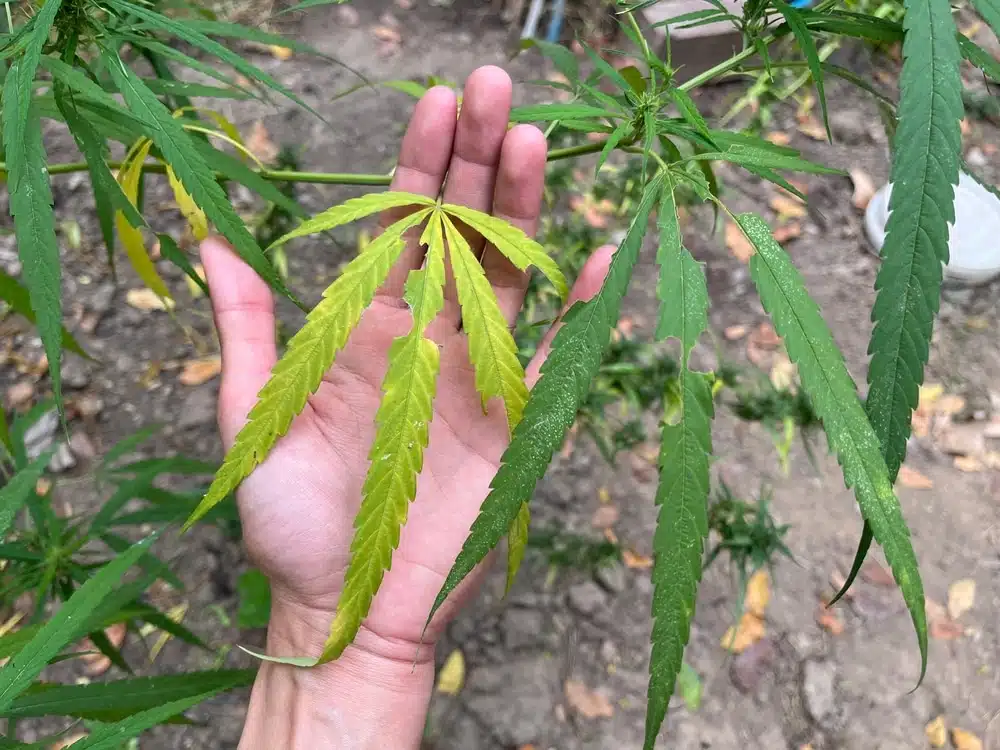
Identifying fungus gnats on weed plants
The first step to dealing with these insects involves knowing what they look like and identifying their presence on weed plants. Here are the common fungus gnat symptoms:
- Physical sighting: Since they fly in groups, you may see several of them together. Larvae and pupae usually hide under the soil and may not be visible to you. A physical sighting may only apply to adult fungus gnats.
- Changes in leaf color: Once attacked by fungus gnats, the leaf color can change to black, pale, or brown with or without dark spots. New foliage may also turn yellow.
- Leaf symptoms: Gray patches may appear on the plant. While only upper, newer, or smaller inner foliage is affected most times, the insects may destroy all leaves in other situations.
- Growth symptoms: Stunted growth, bug infestations, drooping and wilting leaves, and an abnormal appearance are all signs of gnats. Long-term effects may kill your weed plants.
If you notice any of these symptoms on your plants, they might be under attack from fungus gnats.
Getting rid of fungus gnats on cannabis plants
Explore the following methods to find out how to get rid of gnats in your grow room or outdoor setup.
Water less often
Since fungus gnats thrive in damp places, they often attack overwatered plants. The most effective way to deal with these pests is to reconsider how you water your crops.
Do you water your plants too often? Is the soil around the crops always wet? Change your watering schedule and only irrigate marijuana when the ground is dry.
This method ensures fungus gnats don’t have enough decomposing materials to feed on and breed. After doing this for some weeks, the insects will probably disappear on their own.
While using this technique to eradicate the pests, be cautious and avoid underwatering the plants, as it could hamper their growth. Pay attention to the crops and water them once the soil is dry. Ensure ideal humidity and temperature for your growing weed.
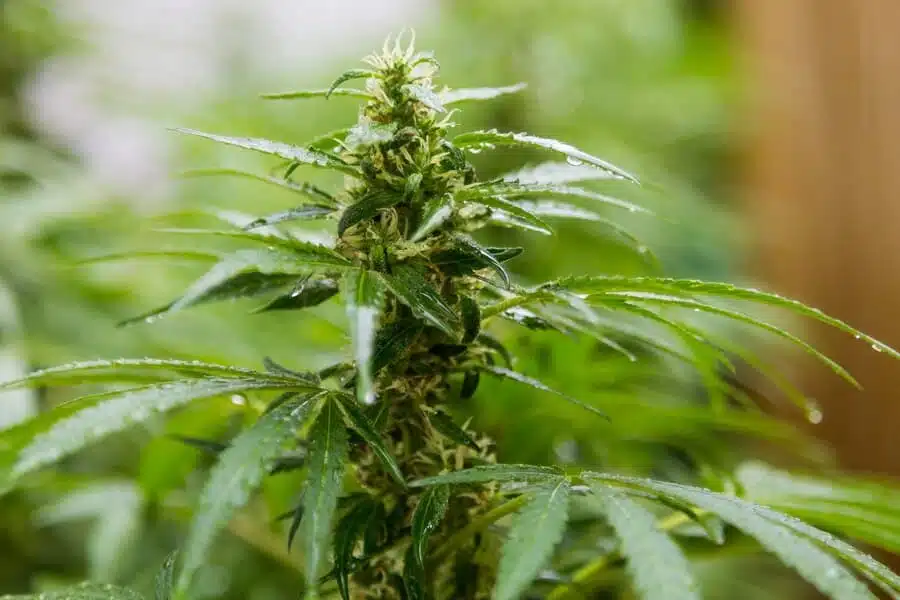
Yellow sticky traps are your best friends
When dealing with fungus gnats, yellow sticky traps play a critical role. These snares have layers of glue to help control the pest population and prevent insects from damaging your cannabis plants.
The traps capitalize on the natural impulse of fungus gnats to fly toward yellow items. Once the insects get to the snares, they stick to the glue and can’t escape unless they die.
Although these sticky items may not eradicate all pests, they can reduce the number significantly.
Yellow sticky traps are nontoxic and can’t harm humans, pets, or crops. They’re also cheap and don’t require any expertise or experience to use. As long as you follow the manual instructions, setting up the snares is easy.
When using yellow sticky traps, check the number of insects inside your grow room. This method allows you to know the extent of pest infestation you’re dealing with.
Visit gardening stores in your neighborhood to buy yellow sticky traps to get rid of fungus gnats. You can also order them online, as many e-commerce shops sell them.
Repel them with neem oil
Neem oil is extracted from the seeds and fruits of Azadirachta indica (neem tree). Several individuals claim the extract can do numerous things, including repelling fungus gnats.
Otherwise called margosa oil, neem acts as an insecticide. It’s a natural repellent that helps manage pest infestations by making the environment uncomfortable for fungus gnats.
Using neem oil for fungus gnats changes the insects’ hormone systems, lowering their rate of breeding and laying eggs. It also prevents the pests from feeding and kills larvae before they grow wings and become adults.
You don’t have to wait until gnats attack your weed plants before utilizing the oil, as it’s a reliable preventative tool. Adding neem to the topmost soil layer hinders adult insects from living around your crops.
If you don’t want to use neem oil, an alternative method is to apply citronella to fungus gnats. It’s also a natural means of deterring pests from destroying cannabis plants.
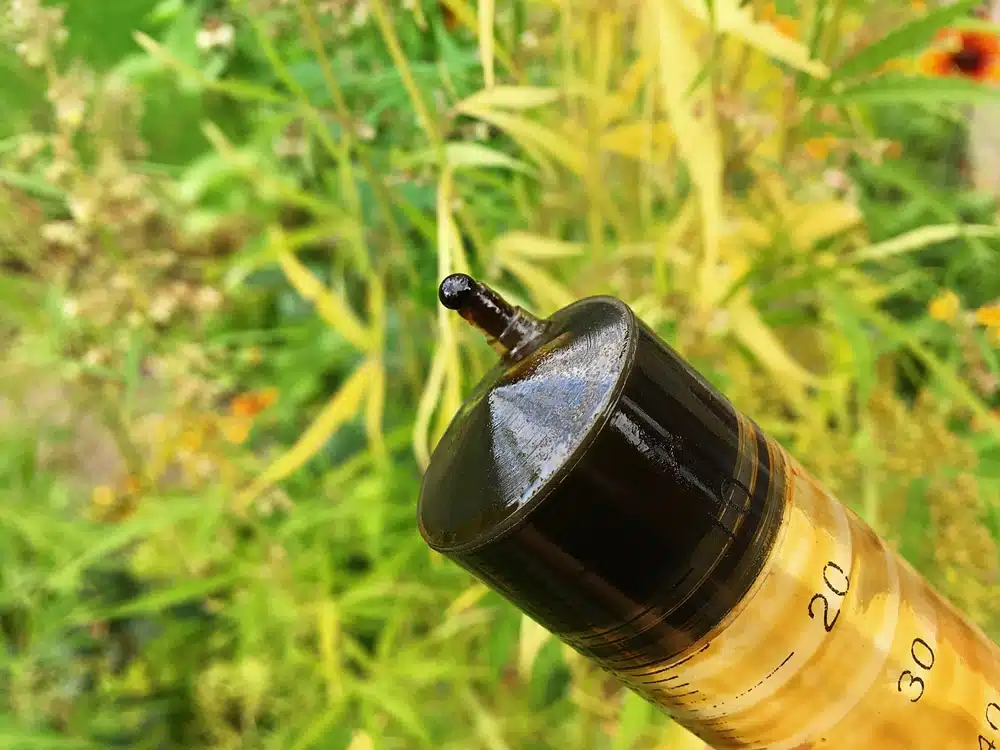
Use diatomaceous earth soil treatment
Diatomaceous earth (DE) refers to sand containing diatoms, the fossils of single-celled aquatic microbes. This naturally occurring, chalk-like material usually comes from sedimentary rocks.
Diatomaceous earth has many industrial and pharmaceutical applications, and it’s an effective treatment for eliminating different insects, including fungus gnats. Diatoms contain several small rock-hard shells that have sharp-edged silica capable of killing pests.
Since these natural materials are useful for different purposes, they come in different levels. If you want to eliminate gnats, select food-grade diatomaceous earth as it’s safe for humans, pets, and plants.
There are several ways to use diatomaceous earth treatment. The simplest option involves sprinkling the powder on the soil surface near cannabis plants and other places where you can see the pests.
Creating a mixture of water and DE can also help eradicate fungus gnats. Add a gallon of water to five tablespoons of diatomaceous earth in a garden pump sprayer. Shake it before spraying directly on weed leaves, stems, and other areas with the insects.
As you spray the mixture, don’t overwater the soil, as this could make the area wet and encourage the pests’ growth.
Increase airflow over the soil
Another way to deal with fungus gnats is by increasing the airflow over the soil. Ventilation damages the insects’ wings and prevents them from flying around your crops.
The method also removes water from the soil quickly, making the environment uncomfortable for the pests. As the insects struggle to live or lay eggs around your cannabis plants, the problem will go away naturally.
Placing some standing fans inside your grow tent can do the trick. Make sure the air flows directly to the plants.
Introduce beneficial Bt bacteria
Bacillus thuringiensis (Bt) is a type of bacteria that breeds naturally in soil and produces toxic proteins. Fungus gnats and mosquitoes like feeding on these microbes. After eating the germs, the toxins generally kill the insects within 24 hours.
Although beneficial Bt bacteria may not eliminate all insects at first, regular applications can help you achieve your goal. Consider introducing the microorganisms to the area once per week for a month.
When selecting the microbes, choose Bacillus thuringiensis subspecies israelensis, which has an affinity for fungus gnats. Add water or horticultural oil to beneficial Bt bacteria for the best results.
Preventing fungus gnats
It’s usually difficult to control fungus gnats after they turn your grow area into their home. Don’t wait until these insects attack or destroy your cannabis plants before taking action. Be proactive and prevent them from coming near your crops.
How do you prevent gnats in a grow tent or outdoor garden? Explore the following methods:
Seriously, water less often!
When dealing with gnats, the essence of watering less often can’t be overemphasized. These insects prefer growing and breeding in wet areas. The more moist your growing medium is, the higher the chance of a pest infestation.
If you successfully reduce the amount of water in the soil around your crops, the environment will be less attractive to fungus gnats. The pests won’t be able to live or lay eggs around your plants.
Use these H2O-friendly techniques:
- Only water the plants when the topmost layer of soil is dry.
- Don’t let any water pool below the growing pots.
- Install standing fans in your grow room to prevent the area from drying up.
Cover the soil
Covering the soil is another preventative measure for keeping fungus gnats and other pests out of your weed plants. This method keeps the insects from going below the ground where they can lay eggs and raise larvae.
It’s recommended that you add a half-inch of the covering to the soil so that the insects can’t dig below it. Before using this technique, check whether the eggs and larvae aren’t already around the plants.
What can you use to cover the soil? Typical options include:
- Sharp, ooid, coral, or gypsum sand
- Decorative moss
- Gravel
- Pebbles
- Crushed granite
When applying the cover, make sure the soil is dry to optimize the effects of the method. Apart from preventing fungus gnats from attacking outdoor or indoor cannabis seeds, this technique can also beautify your grow setup.
Sterilize your soil
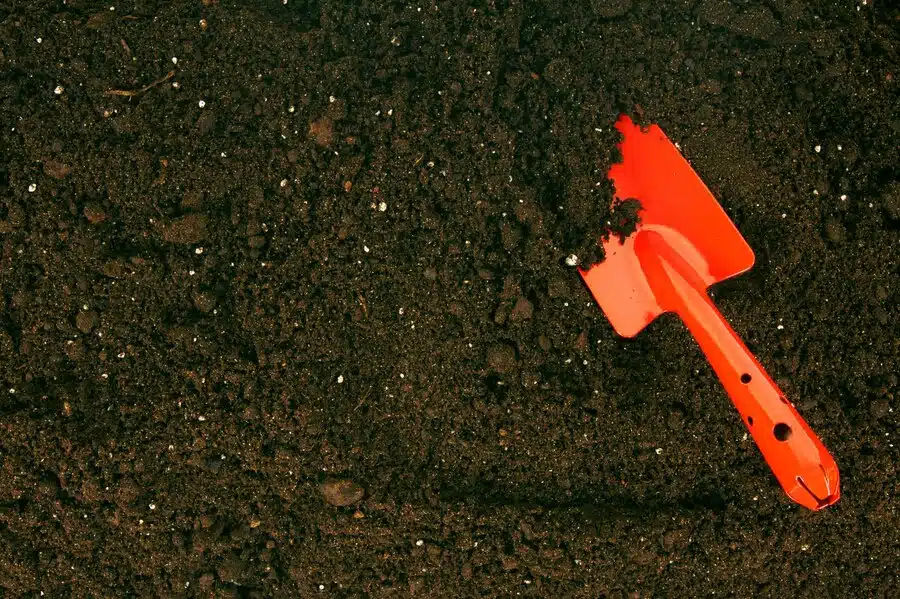
Soil sterilization eradicates pests, pathogens, and other toxic microbes on the ground. The essence of this method is to remove everything that may prevent plants from growing and reaching their full potential. It also makes the earth’s surface healthier.
Sterilizing your soil may curb fungus gnats and enable cannabis plants to grow in a healthy environment.
Common soil sterilization methods include:
- Formalin sterilization: Formalin is a colorless organic compound that deters gnats from getting close to plants. It’s a fast, reliable method for preventing pests.
- Fungicide sterilization: Apply fungicides to the soil around your weed crops to prevent fungi from breeding. The chemicals to use include captan, brasicol, foltaf, and captafol.
- Solar sterilization: This process uses the sun to treat the soil and prevent harmful microbes from growing in it.
- Steam sterilization: This artificial technique involves using vapor to keep germs and other microorganisms away from the soil.
- Soil fumigation: This technique disinfects the soil with the fumes of certain compounds, such as methyl bromide and chloropicrin.
While soil sterilization can help get rid of pests, excess moisture levels and water-logging may cause fungus gnats to continue living on your weed plants. Think about combining this method with other ways of preventing insect infestations.
Try changing to a different grow medium
After using a cannabis grow medium for some time, it may retain more water and require a longer period before drying out. Aging may also make the substrate more susceptible to fungus gnats and other parasites.
Consider changing to a different grow medium, as this may help prevent harmful microbes from thriving in the new area.
Examples of weed grow media to try are:
- Perlite
- Coco coir
- Hydroponic system
- Expanded clay pellets
Keep fungus gnats out of your soil
As you try the methods above, remember that fungus gnats in cannabis and other pests are typically relentless. These insects will continue looking for ways to infest your plants and the soil around them.
Prioritize regular inspections of your weed plants to prevent the pests from proliferating before spotting them. Once you notice fungus gnats and other harmful insects around your crops, get rid of them immediately.
Buy premium marijuana seeds at our store to grow high-quality, healthy marijuana plants.

